Air-conditioned comfort in tomorrow's 400 bhp trucks?
Page 47

If you've noticed an error in this article please click here to report it so we can fix it.
A300 to 400 b.h.p. engine moving a 36to 45-ton combination on motorways at average speeds of about 50 m.p.h., the driver sitting in air-conditioned comfort and having electronic aids to cope with problems of road conditions, visibility at night and in fog, and mechanical condition of his equipment.
This was a picture of transport in the future given by Mr. C. F. Baldwin, director of truck product development, Ford of Europe Inc., when he presented a paper to the Institute of Road Transport Engineers in London yesterday.
Mr. Baldwin dealt with engineering and traffic aspects of high speed /long-distance goods-vehicle operation in the future. There had to be a considerable increase in horsepower, he said, over today's standards. A tractor /trailer combination with a 6 b.h.p. per ton power-to-weight ratio could main tam n 50-55 m.p.h. on a level road but only 20 m.p.h. on a 3 per cent gradient. To maintain 50 m.p.h. on such a gradient would require 16 b.h.p. per ton and although production of vehicles with 600 b.h.p. power units might be remote, there was unquestionably a definite trend towards an increase in power /weight ratios.
Increased demand for small engine size and higher power would cause a rapid spread of high-speed turbocharged vee engines capable of delivering 300 b.h.p. by 1975 and perhaps 400 b.h.p. by 1985, said Mr. Baldwin. Thinking in these b.h.p. categories, one moved very close to the area in which the gas turbine had real advantages. Mr. Baldwin said he believed the real breakthrough for gas turbines would come in the 1980s when European roads would see 40-ton combinations needing 10 to 12 b.h.p. per ton. The lack of reciprocating parts and a liquid cooling system, light bearing loads, low oil consumption and freedom from lubricant contamination would all contribute to low maintenance costs and a long life for the turbine; a figure of up to 500,000 miles appeared possible.
Other advantages included easy starting, clean exhaust, and levels of noise and vibration equal to cars. The diesel had fuel consumption advantages over the turbine, but this was outweighed by the diesel's specific fuel consumption being similar to that of the gas turbine at maximum power, plus the fact that the gas turbine could use lower grade fuels.
Mr. Baldwin said he expected transmission retarders to become essential fittings on the heaviest vehicle-trailer combinations; and semi or fully-automatic transmissions, possibly with computer-type control, would come into prominence. He did not forecast revolutionary changes in axle, brake or suspension design but expected these to develop on present lines. But higher standards would be set for cab design and ease of vehicle control.
The use of computers for freight movement, destination grouping and so on would be essential to ensure the maximum utiliza
tion of long-range, high-speed vehicles of the future. Well-organized workshops, adequately equipped and manned to maintain the vehicles at a high level of fitness and safety, would also be essential. These were major points in the part of his paper dealing with the traffic side of future haulage.
In his closing remarks Mr. Baldwin said that it would be naive to assume easy achievement of the kind of future outlined. The record of artificial limitation and out of date practices was not encouraging. The problem of organization and changes in technology could be overcome but it was hard to conceive what type of road transport we would have had today if the movement of vehicles had remained conditional on the man with a red flag.




















































































































